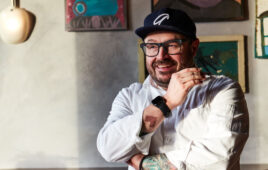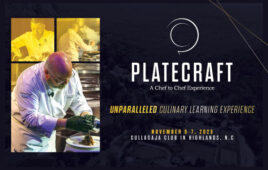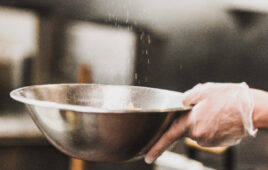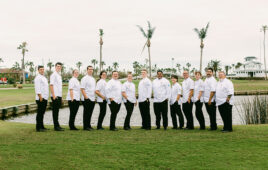As a 30-year-old executive chef preparing for the crowds of a U.S. Open Championship, I would have confidently said, “I’m good; just tell me what you want to see.” At 40 years old, I would have listened intently to anyone’s sage advice if they offered it, but probably not sought it out. But after just turning 50 last month, I’m now old—and wise—enough to know that to provide the best Open food, I need to tap into every resource imaginable. And that would start with an in-depth conversation with the talented chef who most recently staged this notably successful, high-profile event.
God willing, I will be at Merion when it hosts the U.S. Open Championship in 2013. And in starting to prepare for that event, the first person I will plan to call—and the person I’m sure I’ll end up seeking out most often—will be Tom Pepka, Executive Chef at Oakmont Country Club, outside Pittsburgh.
In his “Chef to Chef” interview with me in the July 2005 issue of C&RB (“Oakmont’s Keys to Dining Success”), Tom told me about the unyielding attention to detail and quality that he applies on an everyday basis at his club. As part of this issue’s special focus (see also pg. 12) on the lessons we can all learn from Oakmont’s U.S. Open success, whether or not our clubs will ever host a major golf tournament, I thought it would be good to check back in with Tom to see how he pulled everything off this past June. As always, he was most gracious with his time, and most enlightening with his insights.
Q Well, Chef, now that you’ve been through it, if you had to sum up what it’s been like to direct the food operations for an event like the U.S. Open in one word, what word what that be?
A A lot of words come to mind that would apply, but I guess the best one is “unique.” You think you have an idea going in of just how different this is all going to be, but then it quickly goes way beyond that.
We served over 50,000 meals during the Open week, which is the equivalent of what we do over a full year here at the club. We served 225 buffets and food out of five different kitchens, reset every dining area daily, and removed tons of garbage.
Until you’ve been through it, you can’t imagine what it’s like to prepare for that kind of volume. You start out thinking it will maybe be “five times” what you’re normally used to; then it quickly becomes five times that, and five times that…
Q As you began to sense its full magnitude, how did you keep from getting overwhelmed?
A Well, first, you just make it clear from the start—to yourself and everyone else—that failure is not an option. And each time you run up against a challenge, you keep reminding everyone of that. There are many times when you do have to give yourself, and others, a reminder that many people don’t get this kind of opportunity in their careers—you’ve been entrusted to get it done, and you only have one shot to do it right.
 |
| Even in temporary kitchens, the Oakmont staff maintained excellence and elegance while handling a year’s worth of volume in one week. |
Q Looking back, what proved to be the real keys to success?
A We recognized that we couldn’t start to prepare too early, and that we couldn’t overprepare. Over two years out, we started meeting with everyone—purveyors, the health department, plumbers and electricians, the people who were building tents and kitchens. And I made it a point to spend every free minute working out details of order sheets, temporary stations, and what the duties would be for everyone on the staff. As a staff we went over everything endlessly, and then backed it up with sheets and lists that told what would be coming in, by whom, and when, and then who would do what with it. If you didn’t know something, it was because you chose not to, because no detail was overlooked.
Another key was that we worked with the Pennsylvania Culinary Institute and other schools to line up as much of the staff that we would need as possible. Rather than rely on the general employment pool, we felt it was important to get as many people involved who were interested in a culinary career, even for the most basic jobs. Probably 90 to 95 percent of the people that we used fit into this category, and it really paid off—both for us and for them.
Q Besides the much larger scale, what are the biggest differences of an event like the Open from everyday operations?
A You have to shift into more of a “mass quantity” mindset and focus on speed and simplicity, while still maintaining excellence and elegance. You have to get used to buying things pre-washed and pre-cut, and having more of your meats and other products delivered ahead of time. So you have to really refocus, for example, on preventing cross-contamination. This can be challenging when you’re used to doing everything from scratch.
Q At the same time, are there things you learn that you can go back and apply to “regular” club operations?
A It does help you become more efficient, I think, and also teaches you a lot about how to motivate and train people. And it really showed the value of preparation, which can always be carried over. I think it also just helped us all to realize that the things we think are difficult day-to-day really aren’t that bad and can be overcome. It was interesting, though, to realize that we all had to fight a bit of complacency once it was all over and we went back to normal activities; that was one thing we probably hadn’t fully prepared for.
Q But it sounds like you came out of it all, Tom, without any permanent scars?
A Well, I’m sure it may have shaved a few days off my life, but it was a very special experience that I feel blessed, honored and privileged to have had. I remember sitting on a clubhouse porch on the final Sunday at 5:00 a.m., with people already taking seats in the bleachers as the sun was coming up. That’s when it hit me that after two and a half years of pretty much non-stop preparation, I’d made it to the last day, and that “other shoe” I’d always been waiting to have fall never did. It was a special feeling to know that we’d done it—and not just by meeting our goals, but even exceeding a lot of them.





